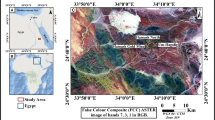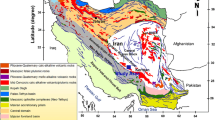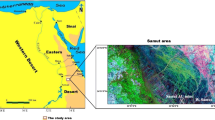Abstract
The study area is located ~50 km in the north of Tehran capital city, Iran, and is a part of central Alborz Mountain. The intrusive bodies aged post Eocene have intruded in the Eocene volcanic units causing hydrothermal alterations in these units. Advanced Spaceborne Thermal Emission and Reflection Radiometer (ASTER) images were used to map hydrothermal alteration zones. The propylitic, phyllic and argillic alteration and iron oxide minerals identified using Spectral Angle Mapper (SAM) method. Structural lineaments were extracted from ASTER images by applying automatic lineament extraction processes and visual interpretations. An exploration model was considered based on previous studies, and appropriate evidence maps were generated, weighted and reclassified. Ore Forming Potential (OFP) map was generated by applying Fuzzy SUM operator on alteration and Pb, Cu, Ag, and Au geochemical anomaly maps. Finally, Host rock, geological structures and OFP were combined using Fuzzy Gamma operator (γ ) to produce mineral prospectivity map. Eventually, the conceptual model discussed here, fairly demonstrated the known hydrothermal gold deposits in the study area and could be a source for future detailed explorations.






Similar content being viewed by others
References
Abedi M, Torabi SA, Norouzi GH (2012) Application of Fuzzy-AHP method to integrate geophysical data in a prospect scale, a case study: seridune copper Deposit. Boll Geofis Teor Appl 54:145–164
Abedi M, Norouzi GH, Torabi SA (2013a) Clustering of mineral prospectivity area as an unsupervised classification approach to explore Copper Deposit. Arab J Geosci 6:3601–3613
Abedi M, Norouzi GH, Fathianpour N (2013b) Fuzzy outranking approach: a knowledge-driven method for mineral prospectivity mapping. Int J Appl Earth Obs Geoinformation 21:556–567
Agar B (2005) ASTER Alteration Mineral Mapping; Northwest Tasmania; Australia. Resource Finance & Investments Limited, Australian Geological and Remote Sensing Services, Annual Progress Report, pp 19
Alavi M R, Mozaffari A, Najaran M (2005) Geochemical Exploration of Precious Metals in Tehran Province. Geological Survey of Iran Research Report, Tehran, Iran (In Persian)
Allen M, Ghassemi M, Shahrabi M et al (2003) Accommodation of late Cenozoic oblique shortening in the Alborz range, northern Iran. J Struct Geol 25:659–672
Almeida-Filho R, Vitorello I (1997) Remote sensing and field data integration in the definition of hydrothermally altered areas in vegetated terrain, central Brazil. Int J Remote Sens 18:1835–1842
Amini M, Emami H (1993) Geological Map of Tehran. Geological Survey of Iran Research Report, tehra, Iran. (In Persian)
Asvadi B (2004) Precious metal mapping in Tehran Geological map quadrangle. Geological Survey of Iran Research Report, Tehran, Iran. (In Persian)
Axen GJ, Lam PS, Grove M et al (2001) Exhumation of the west-central Alborz Mountains, Iran, Caspian subsidence, and collision-related tectonics. Geology 29:559–562
Azizi H, Tarverdi MA, Akbarpour A (2010) Extraction of hydrothermal alterations from ASTER SWIR data from east Zanjan, northern Iran. Adv Space Res 46:99–109
Boleneus DE, Raines G, Causey J et al (2001) Assessment method for epithermal gold deposits in northeast Washington State using weights-of-evidence GIS modeling. US Department of the Interior, US Geological Survey, Menlo Park
Bonham-Carter GF (1994) Geographic information systems for geoscientists: modelling with GIS. Elsevier, The Netherlands.
Buckingham WF, Sommer SE (1983) Mineralogical characterization of rock surfaces formed by hydrothermal alteration and weathering; application to remote sensing. Econ Geol 78:664674
Carranza EJM, Hale M (2001) Geologically-constrained fuzzy mapping of gold mineralization potential, Baguio district, Philippines. Nat Resour Res 10:125–136
Carranza EJM, Hale M (2009) Handbook of exploration and environmental geochemistry, Vol. 11. Elsevier, Amsterdam, p 351
Crosta AP, De Souza Filho CR, Azevedo F, Brodie C (2003) Targeting key alteration minerals in epithermal deposits in Patagonia, Argentina, using ASTER imagery and principal component analysis. Int J Remote Sens 24(21):4233–4240
Eliasi M, Ahmadian S (2008) Inverse method discrimination for geometric arrangements of Kan-Karaj Faults. Geoscience (in: Farsi) 67(5):15–28
Ferrier G, White K, Griffiths G et al (2002) The mapping of hydrothermal alteration zones on the island of Lesvos, Greece using an integrated remote sensing dataset. Int J Remote Sens 23:341–356
Gabr S, Ghulam A, Kusky T (2010) Detecting areas of high-potential gold mineralization using ASTER data. Ore Geol Rev 38:59–69
Ghasemi A, Talbot C (2006) A new tectonic scenario for the Sanandaj–Sirjan Zone (Iran). J Asian Earth Sci 26:683–693
Guest B, Axen GJ, Lam PS et al (2006) Late Cenozoic shortening in the west-central Alborz Mountains, northern Iran, by combined conjugate strike-slip and thin-skinned deformation. Geosphere 2:35–52
Kalinowski A, Oliver S (2004) Aster mineral index processing manual. Remote Sensing Applications. Geoscience Australia. http://www.ga.gov.au/image_cache/GA7833.pdf. Accessed October 2004
Kruse F, Lefkoff A, Boardman J et al (1993) The spectral image processing system (SIPS) interactive visualization and analysis of imaging spectrometer data. Remote Sens Environ 44:145–163
Kruse FA, Boardman JW, Huntington JF (2003) Comparison of airborne hyperspectral data and EO-1 Hyperion for mineral mapping. IEEE Trans Geosci Remote Sens 41:1388–1400
Nykänen V, Salmirinne H (2007) Prospectivity analysis of gold using regional geophysical and geochemical data from the Central Lapland Greenstone Belt, Finland. Gold in the Central Lapland Greenstone Belt: Geological Survey of Finland, Special Paper 44: 251–269
Nykänen V, Karinen T, Niiranen T, Lahti I (2011) Modeling the gold potential of central Lapland, northern Finland. Geoscience for society, Vol. 125. Geological Survey of Finland, pp 71–82
Quadros TF, Koppe JC, Strieder AJ et al (2006) Mineral-potential mapping: a comparison of weightsof evidence and fuzzy methods. Nat Resour Res 15:49–65
Raines GL (1999) Evaluation of weights of evidence to predict epithermal-gold deposits in the great basin of the western United States. Nat Resour Res 8:257–276
Ritz J-F, Nazari H, Ghassemi A et al (2006) Active transtension inside central Alborz: a new insight into northern Iran–southern Caspian geodynamics. Geology 34:477–480
Rowan LC, Mars JC (2003) Lithologic mapping in the Mountain Pass, California area using advanced spaceborne thermal emission and reflection radiometer (ASTER) data. Remote Sens Environ 84:350–366
Rowan LC, Goetz AF, Ashley RP (1977) Discrimination of hydrothermally altered and unaltered rocks in visible and near infrared multispectral images. Geophysics 42:522–535
Rowan LC, Schmidt RG, Mars JC (2006) Distribution of hydrothermally altered rocks in the Reko Diq, Pakistan mineralized area based on spectral analysis of ASTER data. Remote Sens Environ 104:74–87
Sabins FF (1999) Remote sensing for mineral exploration. Ore Geol Rev 14:157–183
Takashima T, Masuda K, Sano I et al (2001) Atmospheric correction for the ASTER visible data on Terra satellite. Adv Space Res 28:177–182
Tommaso I, Rubinstein N (2007) Hydrothermal alteration mapping using ASTER data in the Infiernillo porphyry deposit, Argentina. Ore Geol Rev 32(1–2):275–290
Acknowledgments
The authors gratefully acknowledge the Geological Survey of Iran (GSI) for preparing the data. We would like to thank the unknown reviewers for their constructive comments on early drafts of the manuscript, which helped us improve our paper.
Author information
Authors and Affiliations
Corresponding author
Additional information
Communicated by: H. A. Babaie
Rights and permissions
About this article
Cite this article
Moradi, M., Basiri, S., Kananian, A. et al. Fuzzy logic modeling for hydrothermal gold mineralization mapping using geochemical, geological, ASTER imageries and other geo-data, a case study in Central Alborz, Iran. Earth Sci Inform 8, 197–205 (2015). https://doi.org/10.1007/s12145-014-0151-9
Received:
Accepted:
Published:
Issue Date:
DOI: https://doi.org/10.1007/s12145-014-0151-9




